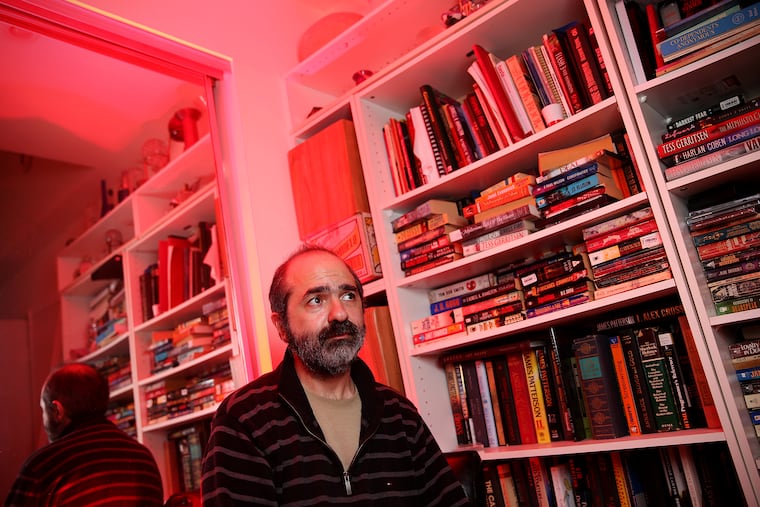After making a horror movie, he’s living in one
Not long after completing his most successful independent horror film yet, David Boorboor was diagnosed with a horrific condition known as burning limb syndrome.

Four years ago, filmmaker David Boorboor attended the Philly premiere of his movie A Place in Hell.
That could be the title of his life story since then.
The 46-year-old director and screenwriter was diagnosed in 2016 with complex regional pain syndrome (CRPS), a rare, chronic, and incurable neurological condition also known as burning limb disease, for the excruciating sensations many patients experience.
“I have burning, stabbing pain in my back and in my limbs. Today I woke up and my hands were burning," Boorboor said recently from his home in Marlton.
He first noticed what he now realizes were the first signs of CRPS in March 2016. “I was editing a project at a friend’s when I started having pain in my lower back,” Boorboor recalled. “It was so bad that even driving home, I knew that something was really wrong. It was the intensity and the [nature] of the pain."
Three years later, “I feel like I’m trapped in someone else’s body, like my body is not my own,” he said, describing his daily life as on a continuum between “being barely able to function and being in bed."
“My dream of filmmaking and my creativity are completely gone," said Boorboor. "So much of my energy is just focused on trying to make it through the day.”
Also called “the suicide disease” because of the debilitation and despair its symptoms can cause, CRPS affects perhaps 500,000 Americans and often is misdiagnosed. Its cause is unknown, although “it typically occurs after an injury,” said Philip Getson, a physician in Marlton who has treated Boorboor and hundreds of other CRPS patients. The condition affects mostly young or middle-aged women, although victims range from “8 to 80 years old” and about 20 percent are men, he said.
“Incurable doesn’t mean it’s not manageable,” added Getson, a resource and advocate for CRPS patients through his website, drgetson.com. He urges avoidance of gluten — “the most inflammatory food on the planet” — as well as sugar and caffeine. Physical therapy, electrical stimulation, and medications also are among “a litany of things” that can be helpful, and he supports patients exploring alternative treatments.
“I want people to be part of the cure, and do all that they can to help themselves, as long as it’s not harmful,” Getson said.
Boorboor has seen specialists and has been on and off a dozen drugs prescribed to treat CRPS. He was enrolled in a trial of an experimental medication and has tried hyperbaric oxygen therapy twice. Dietary changes? Acupuncture? Chiropractic? Vitamins and other supplements? He’s done or is doing them all, and more.
“I’ve had the latest and the greatest of treatments,” said Boorboor, who has launched a fundly.com campaign to help pay for a 10-week holistic regimen at an Arkansas clinic called the Neurologic Relief Center. He also is slated to receive support from the Burning Limb Foundation, a Texas nonprofit that assists CRPS patients seeking treatment at the Relief Center, or at other programs.
“Our grants are $500 to $1,000,” said Philip Robert, the foundation’s CEO and a patient whose CRPS is in remission. “We do not pay for prescriptions, and we ask that you are actively taking a part in your own recovery. We tell them, ‘Be an advocate for yourself. Keep asking questions.’ ”
People with CRPS “can get preyed upon by [others offering] the ‘new best cure,’ ” said Robert. “Or they’re told, ‘It’s all in your head.’ We hear that a lot.”
Katinka van der Merwe, a chiropractor and the clinic’s founder, said traditional medicine aims to “stop the pain or interrupt the pain” of CRPS, which she compared to applying a band-aid.
“The pain is there for a reason,” she told me. “We open the communication along the nerve pathways. We repair the loop.”
Fascinated with movies since seeing Raiders of the Lost Ark as a youngster, Boorboor made his first horror film while a student at Rowan University, did a stint in the U.S. Marine Corps, and has been scripting and directing short films and documentaries for more than a dozen years.
I first met him in 2011 when he was shooting a promotional trailer in Haddonfield for an as-yet unmade supernatural film called The Underground. Later, I saw him work on the set of A Place in Hell, the serial killer/burned-out-detective/college-film-students-in-peril picture that premiered in Philly in October 2015.
Shot on location in South Jersey and Philly, Boorboor’s first full-length feature won a Garden State Film Festival prize, was released on DVD and other formats, and is available on YouTube. Some reviews were lukewarm, and A Place in Hell didn’t make anyone rich, but the movie looked as if it might propel Boorboor’s career to the next level.
“I was excited," he said. “I felt like I had the world on a string. CRPS couldn’t have come at a worse time.”
If he goes into remission, Boorboor hopes to resume his career: “I want to make movies again. I’ve got a feature in mind, but first I want to make a documentary about this illness. It could help a lot with awareness."
When I asked him about the feature, he unspooled the sort of pitch a filmmaker might make to a producer.
“It’s a supernatural thriller. A young boy is abducted and eight years later we meet a family across the street from the family who lost that boy,” he said, before telling me how the movie he hopes to make will end.
Don’t worry, no spoilers.
Let’s just say the lost boy finds a way back.